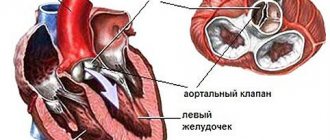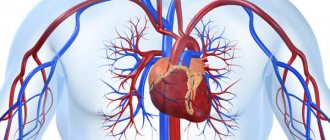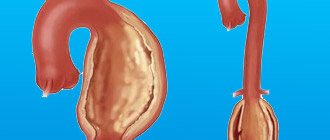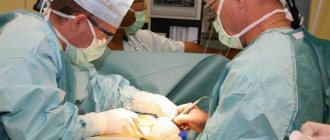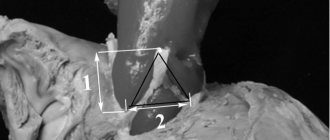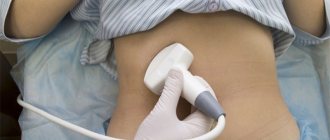Atherosclerosis is a pathological process in blood vessels that is chronic. Danger of atherosclerosis: over time, this disease causes serious circulatory problems. There is a disruption in both fat and protein metabolism in the human body.
Atherosclerosis must be treated without fail, otherwise it can lead to such serious diseases as heart attack, stroke, aortic aneurysm, coronary heart disease, cerebral ischemia, inflammatory processes in the gastrointestinal tract, renal failure and others.
The disease process is as follows:
- There is a violation of fat/protein metabolism. There is an increased amount of lipids in the blood.
- “Excess” amounts of lipids remain on the walls of the arteries.
- After this, overgrowth with fibrous tissue occurs.
- The vessel narrows and ceases to supply the organs and tissues with blood in the required volume.
This disease is mostly related to age: most often it affects men - 40-60 years old, women - 50+ years old. However, there is an alarming trend in the number of sick people and the age under 40 years of age. This is largely caused by improper and unbalanced nutrition and the worsening environmental situation.
Atherosclerosis “strikes” the arteries, including the aorta, carotid arteries, arteries of the brain, and heart. For this reason, this disease is one of the most common causes of myocardial infarction and coronary heart disease, stroke, and circulatory problems.
Types of atherosclerosis
There are different types of atherosclerosis. The classification of the disease is based on the site of origin of the process and, accordingly, on which organ receives insufficient blood circulation. The following types of atherosclerosis are distinguished:
- heart vessels (coronary atherosclerosis);
- cerebral vessels (cerebral atherosclerosis);
- aorta (in the abdominal/thoracic cavity);
- renal arteries;
- arteries of the lower extremities;
- arteries of the upper extremities;
- atherosclerosis of the penile arteries.
Manifestations
There are several stages of the disease, which differ in the degree of damage to the aorta. The initial stage has no clinical manifestations, and atherosclerotic plaques can only be identified by performing a computed tomography scan of the abdominal cavity. The condition of the inner wall of the aorta is gradually deteriorating, which is expressed in the following symptoms:
- heaviness and discomfort in the abdominal area;
- aching night pains that occur after eating and radiate to the groin and lower back;
- indigestion;
- unstable stool;
- the occurrence of heartburn and nausea after eating;
- pulsation and tension in the navel area on the left side.
In the absence of timely treatment, the kidneys are involved in the pathological process. In the patient, this is expressed in difficulty urinating, swelling of the limbs and face, as well as pain in the lumbar region. If atherosclerotic lesions of the aorta occur in the area of its division into the iliac arteries, circulatory disturbances occur in the lower extremities.
In this case, the following symptoms are possible:
- swelling of the legs;
- erectile dysfunction;
- ulcerative formations on the skin of the legs;
- decreased muscle tone;
- loss of pulsation in the feet;
- numbness and cold feet.
No ads 2
As a result of thrombosis of the visceral arteries, which arise from the aorta and nourish the internal organs, the patient experiences intense pain in the abdominal area. This symptom is caused by the death of intestinal cells. In addition, intestinal motility is disrupted, the patient complains of attacks of nausea and vomiting, increased body temperature, constipation followed by diarrhea.
All this interferes with a person’s ability to work. As a result of thrombosis, peritonitis can develop, and this is a life-threatening condition. Atherosclerosis of the abdominal aorta is characterized by the development of abdominal ischemic syndrome. It, in turn, is manifested by the following triad: abdominal pain, intestinal dysfunction, weight loss with adequate nutrition.
Symptoms of atherosclerosis of the abdominal aorta are classified according to the clinical manifestations of the disease into 3 types: abdominal form, dysfunction of the small and large intestines. In the first case, the liver, part of the duodenum and pancreas are affected. The disorders manifest themselves mainly as pain in the abdominal region.
If the branches of the aorta that supply the small intestine are affected, the patient experiences impaired motility, intestinal obstruction may develop, flatulence appears, and rectal bleeding is possible. With atherosclerosis of the branches responsible for the functioning of the colon, a person experiences bloating, ulcers form on the mucous membrane and bleeding from the rectum.
Abdominal pain is one of the main symptoms of atherosclerosis of the abdominal aorta
Stages (stages) of disease development (pathogenesis of atherosclerosis).
Fat streak stage.
Small lipid spots (only one or two millimeters) are immediately present on the walls of the vessel. Then they grow and “unite” with each other. Macrophages destroy them and transform into foam cells, from which fatty stripes appear. This is a normal process, the presence of which does not in any way indicate that a person may develop atherosclerosis in the future.
Stage of fibrous plaques.
The growth of connective tissue develops from fatty stripes, from which fibrous plaques are subsequently “born”. Initially, they are not solid and can be dissolved - with early detection and assistance provided to the patient. Later, fibrous plaques harden as calcium salts are deposited in them.
Stage of complex disorders.
The next stage is a violation of the integrity of fibrous plaques: cracks and tears appear on them. Platelets attach to such a plaque, causing partial or complete blockage of the vessel.
Causes of acute intestinal ischemia
- Atherosclerosis of the intestinal arteries can lead to their thrombosis with the subsequent development of mesenteric ischemia. If there are signs of coronary heart disease, atherosclerotic lesions of the arteries of the legs in a patient, systemic atherosclerosis can be implied and, accordingly, the risk of abdominal ischemia can be taken into account.
- High or low blood pressure increases the risk of mesenteric thrombosis and intestinal ischemia
- Heart failure and atrial fibrillation increase the risk of intestinal arterial embolism (transfer of a blood clot from the heart to the arteries) and acute intestinal ischemia.
- Increased blood clotting in thrombophilia, sickle cell anemia and antiphospholipid syndrome.
- Cocaine and methamphetamine use can cause intestinal vasospasm and intestinal ischemia.
Symptoms of atherosclerosis
The first period of atherosclerosis is the preclinical (asymptomatic) period. During this period, the disease does not make itself known in any way, while a high (exceeding the norm) amount of β-lipoproteins or cholesterol is detected in the human blood. Clinical manifestations occur only after the vessel becomes 50% narrower (or more). The symptoms of this disease depend on which artery or aorta is affected.
Atherosclerosis of cerebral vessels.
Symptoms:
deteriorated memory function, low poor performance, sleep problems, dizziness. As it progresses, the patient’s psyche becomes impaired. The following complications may also make themselves felt: thrombosis and hemorrhage.
Atherosclerosis of the heart vessels (coronary vessels).
Symptoms:
myocardial infarction, cardiosclerosis, angina pectoris.
Atherosclerosis of the thoracic aorta.
Symptoms:
severe pain behind the sternum, radiating to the upper abdomen or back and arm. Duration: the continuation of such pain occurs from a couple of hours and even up to several days.
Atherosclerosis of the abdominal aorta.
Symptoms:
constipation, flatulence, pain in the abdominal area; in addition, numbness of the legs and swelling of the feet may occur.
Atherosclerosis of the renal arteries.
Symptoms:
unilateral damage - gradual development and intensification of hypertension with constantly high blood pressure numbers; bilateral damage - arterial hypertension. Low back pain may also be present.
Atherosclerosis of the arteries of the lower extremities.
Symptoms:
pain in the calves or a feeling of weakness in them, a feeling of numbness in the legs.
Atherosclerosis of the penile arteries.
Symptoms:
erection problems, impotence.
Complications
The consequences of atherosclerotic lesions of the aorta include such dangerous conditions as dissecting aortic aneurysms, renal failure, and stroke.
- Aneurysms are considered one of the most serious complications of atherosclerosis. Enlarged areas appear due to weakening of the vascular wall. The danger of an aneurysm of the abdominal aorta or its thoracic region is the rupture and dissection of the artery, as a result of which the patient risks dying on the way to the hospital. We wrote more about the treatment of abdominal aortic aneurysm here.
- The formation of blood clots in the aortic arch leads to cerebral ischemia and stroke.
- A complication of damage to the buffering zone is the development of necrosis of leg tissue, as well as with obliterating atherosclerosis of the lower extremities. This leads to limb amputation and disability.
How is atherosclerosis treated, what options exist?
For atherosclerosis, treatment is carried out comprehensively. A person must adhere to a diet. The diet is drawn up by a doctor, limiting fatty foods (primarily animal fats), simple carbohydrates and salt, and the person must also give up bad habits - smoking and drinking alcohol, and perform light physical activity (therapeutic exercises). In addition, the patient begins taking a course of medications, the task of which is to remove excess cholesterol from the human body, as well as aimed at reducing the activity of the body’s “production” function of cholesterol. If the above steps do not work, as well as in the case of a high probability of arterial blockage, then the patient is prescribed surgical intervention.
Unfortunately, atherosclerosis is an irreversible disease and it is completely impossible to cure it.
Treatment
In case of chronic course, preference is given to conservative therapy . It aims to reduce lipid levels through diet and lipid-lowering drugs. Vasodilators, antithrombotic drugs and symptomatic therapy are also prescribed.
In case of acute onset of the disease, it is almost always necessary to resort to surgical treatment aimed at restoring optimal blood flow to the tissues of the abdominal cavity. If the surgical intervention was timely, then this allows us to predict the patient’s recovery, despite the seriousness of the condition.
| Name of service (price list incomplete) | Price, rub.) | In installments* |
| Appointment (examination, consultation) with a cardiovascular surgeon, primary, therapeutic and diagnostic, outpatient | 1 750 | — |
| Program “Risk of atherosclerosis and ischemic heart disease, predisposition to dyslipidemia” | 19 000 | — |
* You can read more about the conditions here - Treatment on credit or in installments.
Prevention of atherosclerosis
A healthy lifestyle is the main way to prevent atherosclerosis. Only a nutritious and balanced diet, sufficient physical activity, and giving up bad habits will have a positive effect on the condition of blood vessels. In addition, a mandatory method of prevention (or at least identifying the disease at an early stage) is to pay attention to your health: preventive examinations by doctors and taking a cholesterol test. If you have hypertension, you must constantly monitor your blood pressure and take the necessary medications; if you have diabetes, maintain normal blood sugar levels.
Watch your health and remember that a healthy lifestyle is necessary for everyone!
Diagnostics
To identify atherosclerosis of the abdominal aorta, a number of examinations are performed. Among the instrumental diagnostic methods there are:
- electrocardiogram;
- rheoencephalography;
- ultrasound examination of the abdominal cavity;
- angiography;
- fluorogram;
- duplex or triplex scanning.
All these diagnostic methods make it possible to determine the state of blood flow from the aorta to the organs. At the initial appointment, the doctor collects anamnesis and examines the patient. Blood is donated to determine cholesterol levels. If the initial stage of atherosclerosis is suspected, the following methods are additionally used:
- sphygmogram (pulse fluctuations in the artery are determined);
- electrokymogram (vessel density is determined);
- ballistocardiogram (the contractile function of the myocardium is studied).
Methods for diagnosing atherosclerosis
Starting from the age of 45, it is advisable to undergo annual preventive examinations, especially for men.
Laboratory and instrumental studies are used to diagnose atherosclerosis.
The earlier the disease is detected, the lower the risk of complications. Effective treatment can slow down the development of atherosclerosis and improve the patient's condition. To undergo an initial examination, you can contact, first of all, a general practitioner (general practitioner or family doctor), as well as a cardiologist (if you are worried about your heart) or a neurologist (if you have neurological symptoms - memory impairment, dizziness, decreased attention, sleep disorders ).
Laboratory diagnostics
"Family Doctor" offers to use the laboratory profile "Diagnostics of atherosclerosis", which includes the necessary types of tests.
ECG
In the diagnosis of atherosclerosis, ECG is used in conjunction with other instrumental studies. As a basic cardiac procedure, the ECG usually precedes other diagnostic tests.
More information about the diagnostic method
Echocardiography
Echocardiography is an informative method of instrumental examination of the heart and coronary vessels using ultrasound. Echocardiography (Echo CG) makes it possible to assess in real time the nature of damage to the walls of the coronary vessels, the presence of blood clots in them, as well as the speed of blood flow. Used to diagnose atherosclerosis of the coronary vessels.
More information about the diagnostic method
Ultrasound Dopplerography of blood vessels
Ultrasound Dopplerography of vessels allows you to determine their diameter, wall thickness, identify intraluminal formations (atherosclerotic plaques, blood clots), assess the condition of venous valves, and detect blood flow disorders. Depending on the situation, ultrasound examination of vessels of various locations (cerebral vessels, brachiocephalic arteries, vessels of the lower or upper extremities, renal arteries) is performed.
Angiography
The essence of the angiography method is that a radiopaque substance is injected into the circulatory system, which makes it possible to visualize blood flow in problem vessels.
To diagnose the condition of the heart, aorta and its large branches, radiography, computed tomography and MRI examination of the chest organs can be used.
Sign up for diagnostics To accurately diagnose the disease, make an appointment with specialists from the Family Doctor network.
Causes of atherosclerosis
It has been established that the following factors favor the development of atherosclerosis:
- smoking. Nicotine and tars contained in tobacco have a negative effect on blood vessels;
- physical inactivity (maintaining a sedentary lifestyle);
- unbalanced diet, primarily abuse of fatty and cholesterol-rich foods;
- alcohol abuse;
- increased emotional reaction (susceptibility to stress);
- arterial hypertension;
- overweight (obesity);
- diabetes.
Factors contributing to the development of atherosclerosis also include the so-called non-modifiable factors (that is, factors that a person cannot do anything about):
- age (the risk group includes persons over 45 years old);
- gender (men are automatically at risk);
- presence in the family history of cases of early atherosclerosis.

